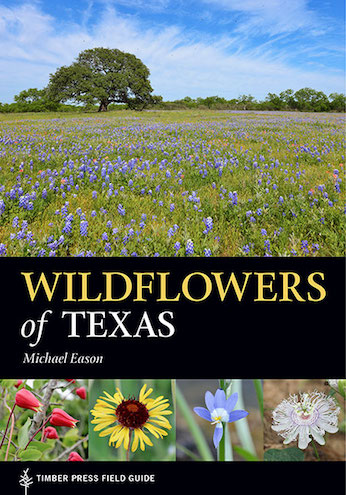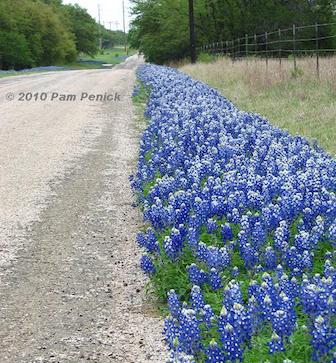Read This: Wildflowers of Texas

An advance guard of bluebonnets scattered across the grassy shoulder of MoPac at Bee Cave Road augurs blue battalions soon to arrive. When they do, green roadsides will surrender and turn sky-blue, touching off the annual frenzy of bluebonnet peeping and photo ops. Parents will crouch before children plopped in their Sunday best among the flowers, crooning for a smile. Country highway traffic will slow to a crawl alongside pastures turned into blue lakes. And in wildflower-loving home gardens, gravelly beds and pathways will suddenly sparkle with white-tipped blue spires rising above star-shaped leaves.
The bluebonnet is beloved by Texans — it’s our state flower after all — but other wildflowers are adored too: Indian paintbrush, pink evening primrose, columbine, white prickly poppy, horsemint, firewheel, Mexican hat, and many others adding threads and patches of color to the wildflower quilt blanketing fields and roadsides in spring and early summer. Plenty more bloom through late summer and fall, including aster, goldeneye daisy, mistflower, gayfeather, and frostweed.
But what if you don’t know a winecup from a windflower? A penstemon from a passionflower? When you’re out on wildflower safari, whether in your local park or along a country road, you’ll get more pleasure out of it if you know what you’re looking at.
“Lara walked along the tracks following a path worn by pilgrims and then turned into the fields. Here she stopped and, closing her eyes, took a deep breath of the flower-scented air of the broad expanse around her. It was dearer to her than her kin, better than a lover, wiser than a book. For a moment she rediscovered the purpose of her life. She was here on earth to grasp the meaning of its wild enchantment and to call each thing by its right name…”
Boris Pasternak, Dr. Zhivago

To this end, Wildflowers of Texas by Michael Eason (Timber Press, 2018) should ride shotgun with you on any flower-peeping drive. This excellent guidebook makes identification easy while also introducing you to the vast number of wildflowers you may encounter throughout the state and the seasons. Pages are color coded by flower hue, and a quick glance at the book’s edge shows you the right section to turn to in order to hunt down a white, yellow, orange, red, pink, purple, or blue flower. Within those sections, plant descriptions are organized by family, so all the gaillardias are together, and all the milkweeds, etc.
Each plant description contains a color photo of the flower or other identifying feature, the botanical name and common names, habitat where it’s found, season of bloom, and a paragraph of helpful information about size and growth habit. The book maps and describes the ecoregions of Texas and illustrates flower parts and leaf forms in the front and end papers. On the back cover, a printed ruler is handy for in-field measurements.
Covering more than 1,200 species of wildflowers and weighing in at 508 pages (Texas is a big state), the book is fairly hefty. While you might not want to tote it on hikes, you can easily consult it in the car or at home to identify wildflowers you took pictures of.
Spring is right around the corner, the advance guard already here. Learn the names of our beautiful native flowers this year, and enjoy another breathtaking Texas wildflower season.
Disclosure: Timber Press sent me a copy of Wildflowers of Texas for review. I reviewed it at my own discretion and without any compensation. This post, as with everything at Digging, is my own personal opinion.
__________________________
Digging Deeper
Come learn about gardening and design at Garden Spark! I organize in-person talks by inspiring designers, landscape architects, authors, and gardeners a few times a year in Austin. These are limited-attendance events that sell out quickly, so join the Garden Spark email list to be notified in advance; simply click this link and ask to be added. Season 8 kicks off in fall 2024. Stay tuned for more info!
All material © 2025 by Pam Penick for Digging. Unauthorized reproduction prohibited.


It has been a recent dream of mine to see those very bluebonnets! Hmmm, how can I make this happen?
Just do it, Robin. 🙂